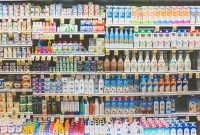- Home
- Business Processes
- Industry Knowledge
- Aerospace Industry
- Automotive Industry
- Banking Domain
- BFSI Industry
- Consumer/ FMCG Industry
- Chemicals Industry
- Engineering & Construction
- Energy Industry
- Education Domain
- Finance Domain
- Hospitality Domain
- Healthcare Industry
- Insurance Domain
- Retail Industry
- Travel and Tourism Domain
- Telecom Industry
- Leadership Skills
- eLearning
- Home
- Industry Knowledge
- Consumer/ FMCG Industry
- Overview of Retail Industry
Overview of Retail Industry
Retailing is the combination of activities involved in selling or renting consumer goods and services directly to ultimate consumers for their personal or household use. In addition to selling, retailing includes such diverse activities as, buying, advertising, data processing, and maintaining inventory. This article explains the meaning of retail and its etymology. Understand the meaning and constituents of the retail industry and the role it plays in the economy of any nation.
Retailing is the combination of activities involved in selling or renting consumer goods and services directly to ultimate consumers for their personal or household use. In addition to selling, retailing includes such diverse activities as, buying, advertising, data processing, and maintaining inventory.
What do we mean by Retail?
According to Phillip Kotler, "Retailing includes all the activities involved in selling goods or services to the final consumers for personal and non-business use." A retailer or a retail store is any business enterprise whose sales volume comes primarily from retailing. A retailer may primarily sell goods such as a grocery store or a bookstore, or a retailer may primarily sell services such as a beauty parlor or a theatre. Retailers are business firms engaged in offering goods and services directly to consumers. In most—but not all— cases, retail outlets are primarily concerned with selling merchandise. Typically, such businesses sell individual units or small groupings of products to large numbers of customers.
A minority of retailers, however, also garner income through rentals rather than outright sales of goods (as in the case of enterprises that offer furniture or gardening tools for rent) or through a combination of products and services (as in the case of a clothing store that might offer free alterations with the purchase of a suit). Retailing is thus a combination of activities involved in selling or renting consumer goods or services directly to the ultimate customers for their personal or household use. In addition to selling, retailing includes such diverse activities as buying, advertising, data processing, manpower management, and maintenance of inventory.
The Etymology of "Retail":
Retail comes from the Old French word tailer (compare modern French retailler), which means "to cut off, clip, pare, divide" in terms of tailoring (1365). It was first recorded as a noun with the meaning of a "sale in small quantities" in 1433 (from the Middle French retail, "piece cut off, shred, scrap, paring"). Some of the "cut" functions retailers perform include sorting and storing, packing, and selling in small quantities to the final consumers thus adding value.
Difference between Shopping & Retailing:
Shopping:
Shopping refers to the act of buying products. Sometimes this is done to obtain necessities such as food and clothing; sometimes it is done as a recreational activity. Recreational shopping often involves window shopping (just looking, not buying) and browsing and does not always result in a purchase.
Retailing:
Retail is the sale of goods and services from individuals or businesses to the end-user. Retailers perform specific activities such as anticipating customer wants, procuring material as per the anticipated demand, acquiring market information, and financing.
The Retail Industry:
Globe: Retailing is the largest private sector in the world and the prime mover of the economy. It accounts for almost 10% of the GDP of most developed nations. Retailing globally is huge-$6.6bn and much of it is organized. The retail industry is predominant in developed countries like the USA, UK, etc. The industry is also a major employer in most of the economies- up to 16% in the US, 15% in Brazil, 12% in Poland, and 7% in China. Typically, the top 250 global retailers have combined sales of approximately $4 trillion USD. The top ten retailers account for $1.2 trillion, or about 30% of those sales.
United States of America: In the USA, the retail industry employs about 22 million people and generates more than three trillion dollars in sales annually. The United States retail sector features the largest number of large, lucrative retailers in the world. A 2012 Deloitte report published in STORES magazine indicated that of the world's top 250 largest retailers by retail sales revenue in the fiscal year 2010, 32% of those retailers were based in the United States and that 32% accounted for 41% of the total retail sales revenue of the top 250. The retail industry is a massive part of the overall U.S. economy and in 2005, retail establishments accounted for 18 percent of all nonfarm private-sector jobs and had sales of $3.2 trillion. Many retail niches are characterized by a healthy population of smaller enterprises and the vast majority of retail employees in the United States work at establishments with fewer than 20 employees. There is also a huge concentration of large retail firms in the USA - 10 % of food and general merchandise firms account for over 40% of all retail sales. Some of these large retail chains eliminate the whole sellers and buy direct from the manufacturers making the supply chain very efficient.
Japan: In Japan, on the other hand, small firms and stores govern the retail sector. The wholesale channel is relatively much larger. Merchandise has to pass through three to four-channel members before reaching the store. This results in reduced efficiency and higher manpower and distribution costs. In Japan, 20% of the workforce is employed in retail as against 10% in the USA.
Europe: In Europe, there is a high concentration of retail sales in some countries like the UK and Germany. In the UK, over 80% of retail sales in food are accounted for by 5 large chains. In Southern Europe, the market is more fragmented and we find traditional small family-owned stores dominating the markets.
Related Links
You May Also Like
-
Retailing is the combination of activities involved in selling or renting consumer goods and services directly to ultimate consumers for their personal or household use. In addition to selling, retailing includes such diverse activities as, buying, advertising, data processing, and maintaining inventory. This article explains the meaning of retail and its etymology. Understand the meaning and constituents of the retail industry and the role it plays in the economy of any nation.
-
Retail Industry: Revenue Model
Understand the traditional retail revenue model and, what are the variations in different revenue models adopted by key players in the retail industry. Analyze the pros and cons of various models. The most common and most profitable revenue model is that of the traditional retailer. The traditional retailer profits by selling products and services directly to buyers at a mark-up from the actual cost.
-
The retail value chain defines a series of actions that enable businesses to sell their products to customers. Value Chain for any industry describes how an industry is structured and its methods for maximizing revenues. Learn the value chain of the industry. Learn about the key partners, key activities, cost structures, and revenue streams of the retail sector. The value/supply chain analysis reveals the business activities which comprise the movement of retail goods.
-
Markets are continuously changing and to understand the dynamics of any industry it is important to understand what is happening and how the industry market players see the future for the industry. In this article, we will discuss the recent trends witnessed by the retail sector. This document provides insights into major trends identified for the retail sector.
-
Retail Industry - Business Model
A retail business model articulates how a retailer creates value for its customers and appropriates value from the markets. In retail, a business model would dictate the product and/or services offered by the retailer, the pricing policy that he adopts. Many different types of retail establishments exist, and, the overall industry has seen a significant blurring of the boundaries that separated the wide range of retail businesses. Understand the key business models adopted by the retail industry. Understand the distinctive ways that retail industry players use to reach to the end consumer.
-
Retail Industry: Key Performance Metrics
You cannot manage what you do not measure and cannot measure what you do not define. Learn the key performance metrics for the retail industry like Sales per square foot, Gross margins return on investment, Average transaction value, Customer retention, Conversion rate, Foot traffic, and digital traffic and Inventory turnover, etc. These metrics are used across the globe by key industry players to track and improve their performance.
-
FMCG or consumer packaged goods (CPG) are products that are sold quickly and at relatively low cost, examples include non-durable goods such as soft drinks, toiletries, and grocery items. They generally sell in large quantities, so the cumulative profit on such products can be substantial and these industries often operate on thin margins.
-
All of us are consumers, from cradle to grave, to be more precise, from the womb to grave or cremation. In a sense, the history of the consumer is the history of mankind. Consumers are the largest economic group in any country. They are the central point of all of our economic activities. But the very same consumers ate the most voiceless group also. The nature of consumer in terms of needs, consumption patterns, and problems has been changing and evolving along with the social and economic development in the course of history.
-
Retail Industry: Strategies for overcoming challenges
To stay competitive in this ever-evolving landscape, it is imperative for retailers to deliver a seamless customer experience and provide the right services and products at the right time. Learn the strategies for overcoming challenges for the retail industry. Retailers must use technology and solutions to revive their businesses in the COVID-19 world. An omnichannel marketing strategy can help retailers reach a wider audience for their brands.
-
Retail Industry: Current Challenges
Today consumers are choosing multichannel buying experiences and expect that to be a seamless experience. To attract customer loyalty, retailers need to provide an experience that stands out from others. Learn the challenges faced by the retail sector today. Multi-channel sale avenues, changing consumer behavior, technological advances, rising competition, rising frauds, and supply chain management are some of them that require immediate attention.
Explore Our Free Training Articles or
Sign Up to Start With Our eLearning Courses

About Us
Learning
© 2023 TechnoFunc, All Rights Reserved










